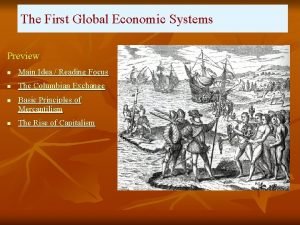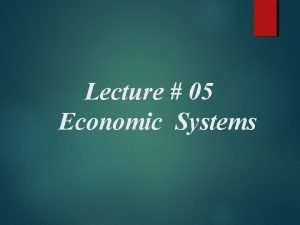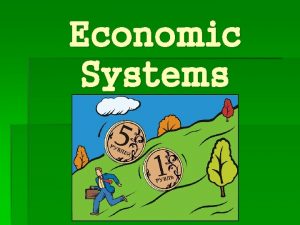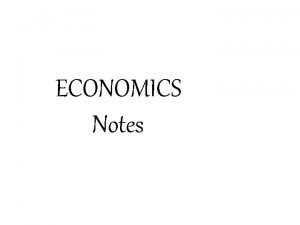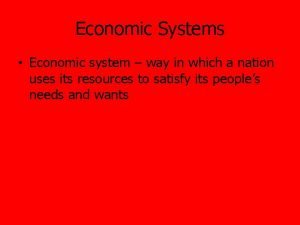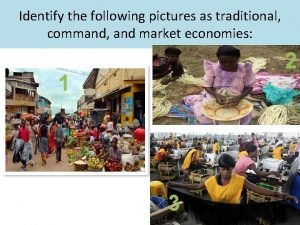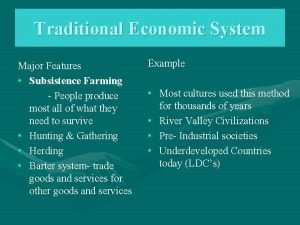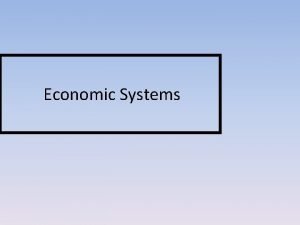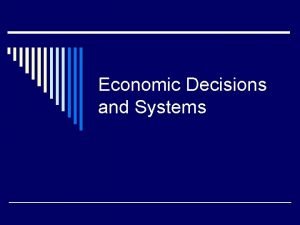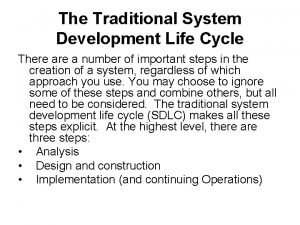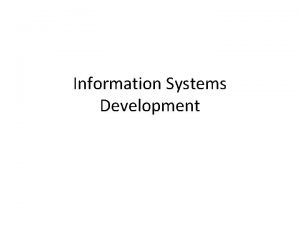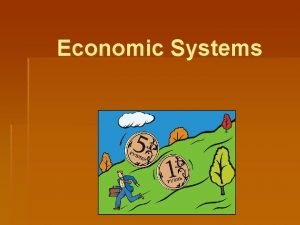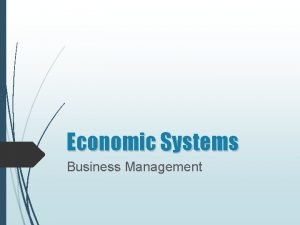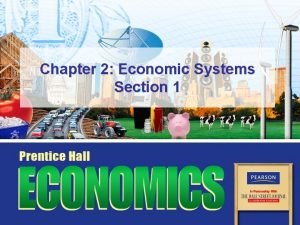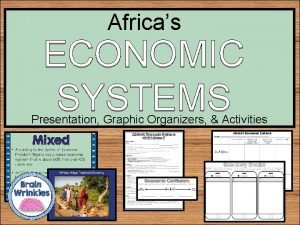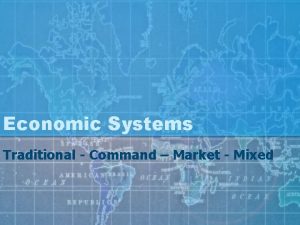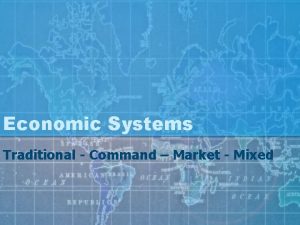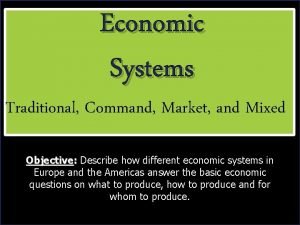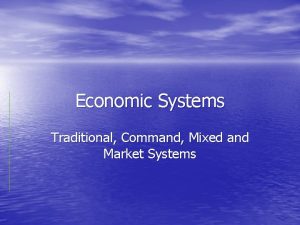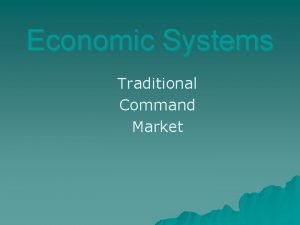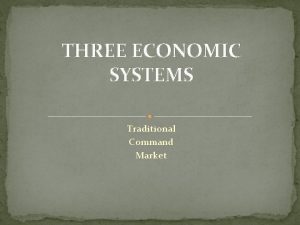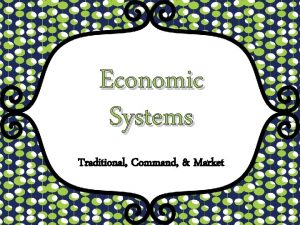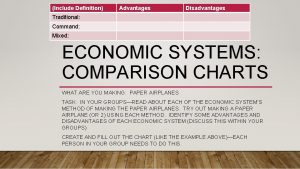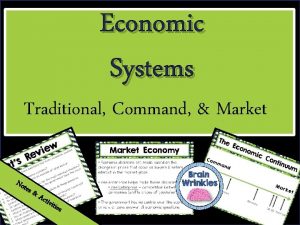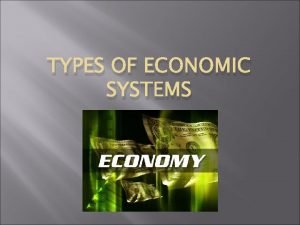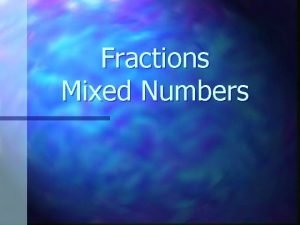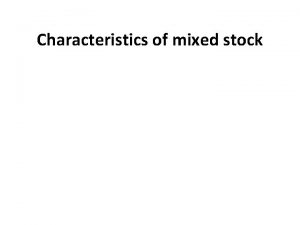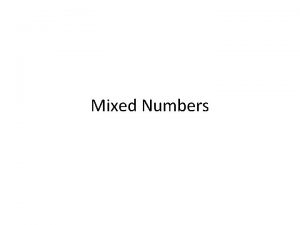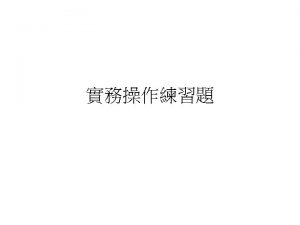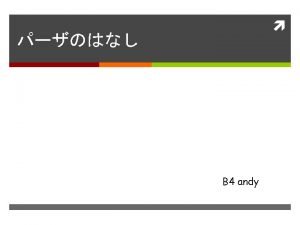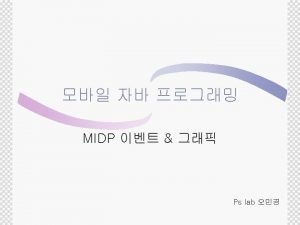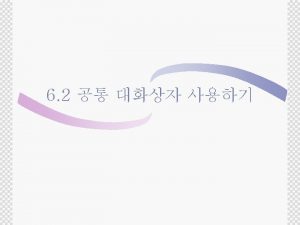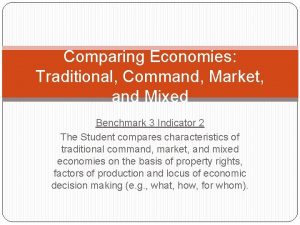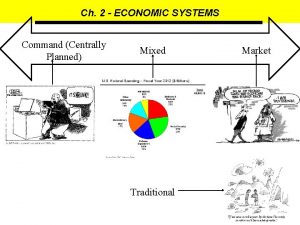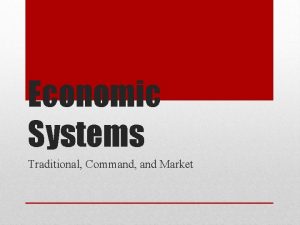Economic Systems Traditional Command and Mixed First 3




























- Slides: 28

Economic Systems Traditional, Command, and Mixed.

First 3 Questions of Economics 1 st- What to Produce 2 nd- How to Produce 3 rd- For Whom to Produce How each nation answers these questions determines what economic system they have.

Traditional Economies *Families, clans, or tribes make economic decisions based on customs/beliefs *The one goal of these societies is survival. Advantages - stable & predictable Disadvantages – discourages progress

Traditional Economy Cont. Example: Haiti, the Amish, indigenous tribes The good of the group always matters more than individual desires Answering the 3 Basic Questions What- what has always been produced will continue to be produced. How- in traditional ways. For whom- the good of the group.

Karl Marx Both socialism and communism were developed from the ideas of Karl Marx studied capitalism and economics for years and he believed that capitalism created a system of wage slavery. The workers’ wages would remain low, but the rich became richer. In The Communist Manifesto, workers would overthrow this system and ownership of factories would be transferred into public hands.

Universal Healthcare

Karl Marx continued… He discussed more of his economic ideas in another book called Das Kapital https: //www. youtube. com/watch? v=1 6 IMc 5 mhb. Zk

Pure Command (Planned) Economies • Government usually owns means of production. (resources and factories) • Advantage – resources can be redirected very quickly • Disadvantages • little economic freedom or economic incentives • wants & needs of individual consumer rarely considered

Pure Command Economy Cont. Closest examples: North Korea or Cuba Answering the 3 Basic Questions What- the government decides. How- by government owned means of production. For whom- the whole group/country

***Pure Market Economy Cont. Based on individual choice, not government directives. Answering the 3 Basic Questions What- the goods consumers will buy are produced. How- by individually owned enterprises For whom- people who can afford them

***Pure Market Economy • • Exchange of goods/services is driven by selfinterest and incentives (free market) Motivated by profit, producers make what consumers want (free enterprise) Advantages • Act in your own self-interest • wide variety of goods/services; efficient Disadvantages • only productive resources rewarded • market failures (monopolies, public goods, etc. ) • unequal income distribution

Which type of economy is this? Government plans how resources are used.

What type of economy is this? The one goal of these societies is survival.

What type of economy is this? Unequal income distribution.

What type of economy is this? Government makes all economic decisions.

What type of economy is this? Exchange of goods/services is driven by self-interest.

What type of economy is this? Families make decisions based on customs.

Economic Continuum (Traditional) Pure Command Pure Market

Economic Continuum Authoritarian Pure Command Socialism Capitalism (free market) Socialism allows election of officials leaves govt. in control of major industries allows free markets for other goods & services Pure Market

Real World Economic Spectrum N o r t h K o r e a C u b a Pure Command C h i n a S w e d e n F r a n c e E n g l a n d H o n g J a p a n U S A K o n g Pure Market

Types of Command Economies Communism: a more extreme form of socialism in which there is no private ownership of property and little/no political freedom.

Mixed Economic Systems *An economic system that has elements of traditional, command, and market economies. -The most common type of economic system.

Economic Systems: Crash Course-10: 00 https: //www. youtube. com/watch? v=B 4 3 YEW 2 Fv. Ds

***Adam Smith is known as the Father of Economics. Wrote Wealth of Nations In this publication he argued that a nation would be wealthier if it engaged in free trade rather than mercantilism. In such a free market, the buyer and the seller benefit from each transaction. https: //www. youtube. com/watch? v=ej. JRhn 5 3 X 2 M 6 min.

Economic Systems Activity With a partner or individually, create a poster that shows the 3 basic questions and how a traditional, command, or market economy answers each of those questions. Make sure that your poster contains at least one illustration for each question. Some information about Economic Systems can be found on page 38 in your textbook.

Economic System Activity Rubric Choose an Economic System (5 points) Neatness (5 points) Write/Answer the 3 economic questions about your economic system. (10 points each) Provide 1 colorful illustration per economic question. (10 points each) Explain each of your illustration. What did you draw? Why did you choose to draw that? (10 points each)

ECONOMIC SYSTEM an organized set of procedures a nation uses in producing and distributing goods and services The system is determined by who answers the 3 basic economic questions

Can you identify each economy? Ex: A farmer and his family living in the rural Midwest of the United States. The farmer’s family has owned the farm for generations. While the family uses modern farming methods, everyone is expected to help out around the farm. The kids go to a public high school, and the grandparents receive a Social Security check every month.
 Economic systems lesson 2 our economic choices
Economic systems lesson 2 our economic choices The first global economic systems
The first global economic systems Mixed economic system
Mixed economic system Economic system mixed
Economic system mixed Command economy pictures
Command economy pictures Command economy
Command economy Traditional economy pictures
Traditional economy pictures Economic growth vs economic development
Economic growth vs economic development Traditional economic system example
Traditional economic system example Economic system features
Economic system features Traditional economic system example
Traditional economic system example Economic growth vs economic development
Economic growth vs economic development Chapter 2 economic systems and decision making answer key
Chapter 2 economic systems and decision making answer key Chapter 2 economic systems and decision making
Chapter 2 economic systems and decision making Free enterprise and other economic systems
Free enterprise and other economic systems Chapter 2 economic systems and decision making answer key
Chapter 2 economic systems and decision making answer key Chapter 1 economic decisions and systems answer key
Chapter 1 economic decisions and systems answer key Comparing economic systems worksheet
Comparing economic systems worksheet Traditional system life cycle
Traditional system life cycle Traditional approach vs object oriented approach
Traditional approach vs object oriented approach Traditional systems development life cycle
Traditional systems development life cycle Education health and famine cloze notes
Education health and famine cloze notes What is the purpose of an economic system
What is the purpose of an economic system Economic system example
Economic system example How many economic systems are there
How many economic systems are there Traditional economy political cartoon
Traditional economy political cartoon Chapter 2 economic systems answer key
Chapter 2 economic systems answer key Lesson 3 the role of government in economic systems
Lesson 3 the role of government in economic systems Africa's economic systems comprehension check answer key
Africa's economic systems comprehension check answer key

